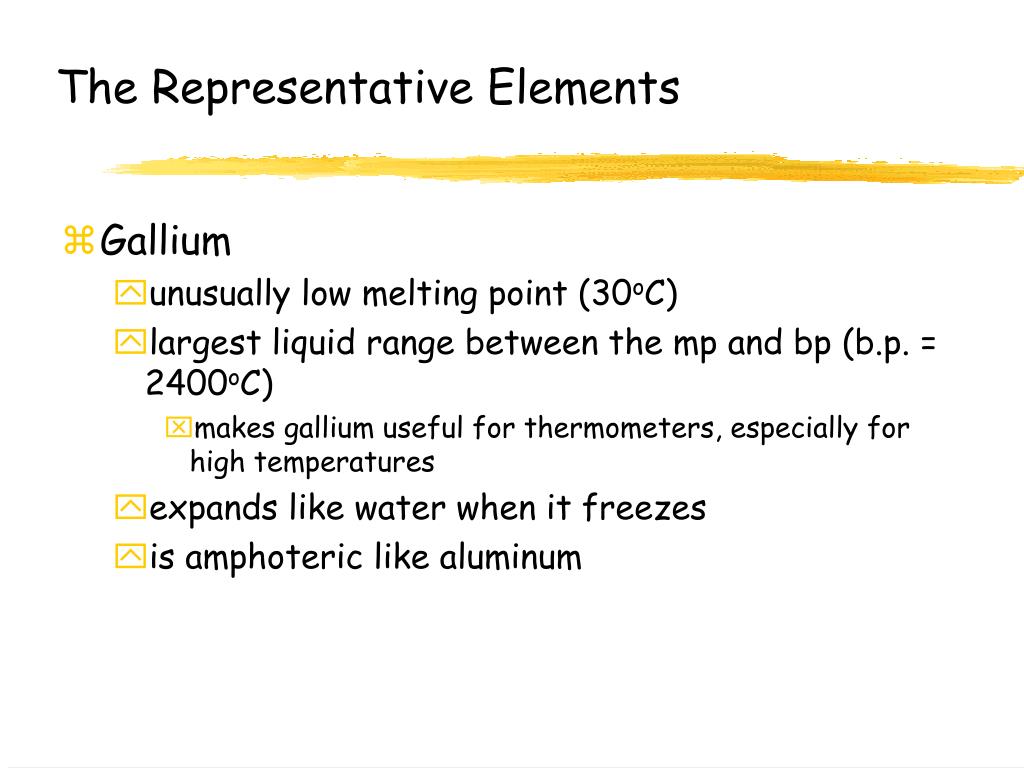

Representative elements full#
The next shell down is now the outermost shell, which is now full - meaning there is very little tendency to gain or lose more electrons. For instance, we already know that the alkali metals (Group I) always form ions with a +1 charge the 'extra' s1electron is the one that is lost: The inner, core electrons (inner shell) don't generally play a role in chemical bonding.Įlements through similar properties generally have similar outer shell configurations. This shell is recognized as the valence shell. Structures of Monatomic Ions: The electrons in the outermost shell (the ones by the highest value of n) are the most energetic, and are the ones that are exposed to other atoms. In the periodic table, elements through the similar number of outermost electrons fall into the equivalent group. In the modern periodic table, elements are organized in order in order of rising atomic number, and the properties of the elements drop into a entirely regular order.Īn element is described through its atomic number (the number of protons in the nucleus of its atoms), but its chemical reactivity is found out through the number of electrons in its outer shells, a property fundamental to the organization of the periodic table of the elements. Chemists began to wonder why similarities existed. Both metals are alike in appearance and undergo reactions through the similar reagents.Īs more and more elemental substances were recognized, more and more similarities between the new elements and previously recognized elements were noticed. For instance, common alkali metals (Na and K) were approximately indistinguishable to early chemists. The Roman numeral and letter descriptions provide the electron configuration for the valence electrons (for instance the valence electron configuration of a Group 15 (formerly group VA) element will be s 2p 3 through 5 valence electrons).Įven in the initial studies of chemistry, it became evident that definite elemental substances were extremely much like other substances in their physical and chemical properties.
Representative elements series#
Group's 3 - 12 (formerly Group B) elements are the non-representative elements, which have partly filled d sublevels (the conversion elements) or moderately filled f sublevels (the lanthanide series and the actinide series). Groups 1 & 2 and 13 - 18 (formerly Group A) elements are the representative elements that have s or p sublevels as their outer orbitals. The Roman numerals establish above each group specify the usual number of valence electrons. Valence electrons find out the properties and chemical reactivity of the element and contribute in chemical bonding.

The electrons in the outer shell are termed valence electrons. Groups comprise elements having the similar electron configuration in their outer shell, which consequences in group elements sharing similar chemical properties. Each of the seven periods is packed sequentially through atomic number. If we want to look at the electronic structures of easy monatomic ions (such as Cl-, Ca 2+ and Cr 3+), we require knowing the electronic structure of the atom and the number of electrons gained/lost in forming the ion.Įlements in the periodic table are arranged in periods (rows) and groups (columns). It supposes that we know about simple atomic orbitals - at least as far as the way they are named, and their relative energies.
Representative elements how to#
This chapter explores how to write electronic structures for atoms and ions using s, p, and d notation. Electronic Structure of the Representative Elements, Chemistry tutorial


 0 kommentar(er)
0 kommentar(er)
